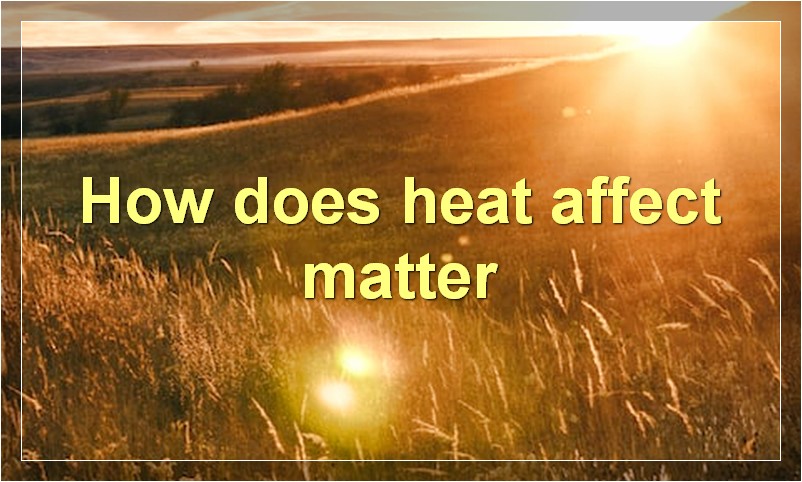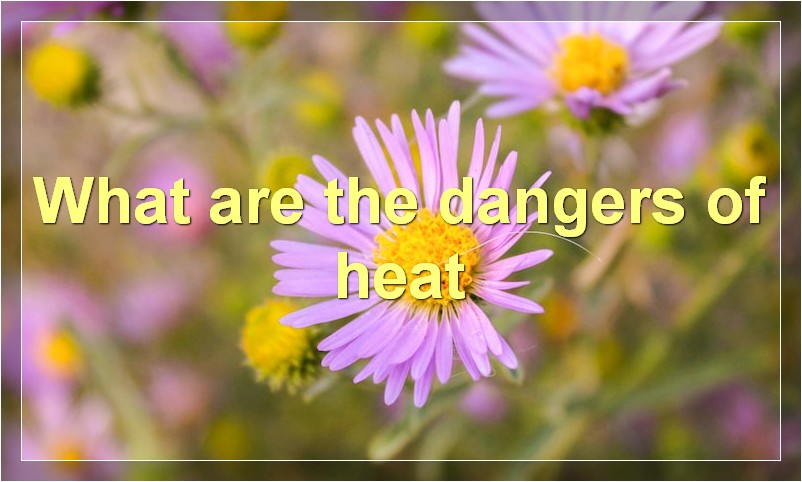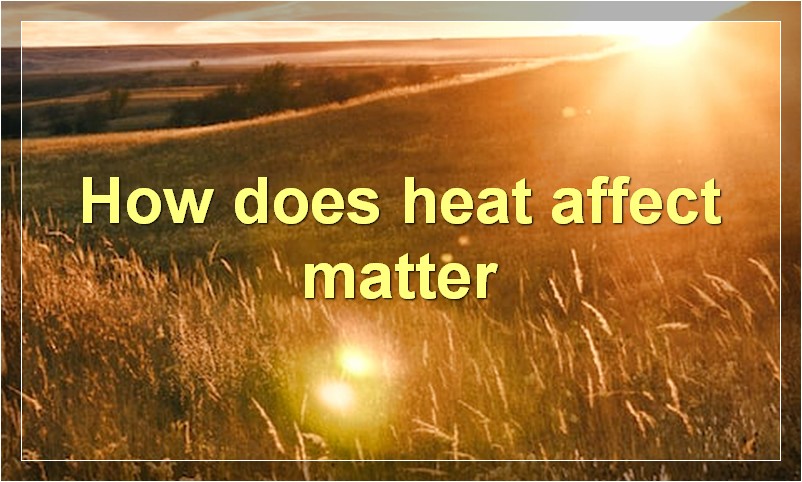The Process Of Heating And Its Effects On Matter
If you’ve ever wondered how your oven heats up your food or what happens to matter when it’s heated, this article is for you.
What is the process of heating something
When it comes to heating something, there are a few key things to keep in mind. First, you need to ensure that the object is evenly heated. This can be done by using a heat source that surrounds the object, such as a furnace. Secondly, you need to control the rate at which the object is heated. This can be done by regulating the heat source, or by using a material that conducts heat well. Lastly, you need to be aware of any potential dangers that come with heating an object, such as fire hazards. By following these steps, you can safely and effectively heat any object.
How does heat affect matter

When matter is heated, the particles that make up the matter gain energy. The particles begin to move faster and take up more space. This is why hot air is less dense than cold air. The particles in hot air have more energy and are spread out more. The increased energy of the particles also makes them vibrate more. This is why hot objects appear to be brighter than cold objects. The increased vibration of the particles makes them emit more light.
What are the different states of matter and how do they change with heat
Thestates of matter are: solid, liquid, gas and plasma. With increasing heat, the particles in a solid gain more energy and begin to vibrate. The increased vibration causes the particles to move further apart, changing the solid into a liquid. If the temperature is increased further, the particles gain even more energy and begin to move independently of each other, changing the liquid into a gas. If the temperature is increased even further, the electrons in the atoms can be stripped away, creating ions and changing the gas into plasma.
What are some methods of heating things
There are three primary methods of heating things: conduction, convection, and radiation.
Conduction is the transfer of heat through solid objects. It occurs when hot particles come into contact with cooler particles, and the hot particles transfer some of their heat to the cooler particles. This process happens without any movement of the object as a whole. The speed of heat conduction depends on the material; some materials are better conductors than others.
Convection is the transfer of heat through fluids (liquids and gases). It occurs when hot fluids circulate and come into contact with cooler objects, transferring heat to them. This process requires movement of the object as a whole. The speed of heat convection depends on the density of the fluid; denser fluids have a slower rate of convection than less dense fluids.
Radiation is the transfer of heat through electromagnetic waves. It occurs when hot particles emit electromagnetic waves, which are then absorbed by cooler particles. This process does not require any contact between the objects; they can be separated by a vacuum. The speed of heat radiation depends on the temperature of the emitting object; hotter objects radiate heat faster than cooler objects.
What are some applications of heat
Some applications of heat energy include:
-Cooking food
-Heating homes and buildings
-Drying clothes
-Generating electricity
What are the dangers of heat

There are a few dangers that come with heat. The first is dehydration. When it’s hot outside, we sweat to cool ourselves down. But sweating also causes us to lose water and electrolytes, which can lead to dehydration. Symptoms of dehydration include headache, dizziness, and fatigue.
The second danger is heat exhaustion. This happens when our bodies can’t regulate our internal temperature and we start to overheat. Symptoms of heat exhaustion include heavy sweating, weakness, fainting, and nausea. If not treated, heat exhaustion can lead to heat stroke, which is a life-threatening condition.
So how can you stay safe in the heat? Make sure to drink plenty of fluids, especially water. Avoid alcoholic beverages and sugary drinks, as they can actually cause dehydration. And take breaks often if you’re going to be out in the heat for extended periods of time. Find a cool place to rest, and if possible, take a cool shower or bath.
How can heat be used to improve things
How can heat be used to improve things?
Well, let’s think about this for a minute. How do we usually use heat? We use it to cook food, to keep ourselves warm, and to dry things. So, how can we use heat to improve things?
One way is to use heat to cook food. This can be done in many different ways, such as using a stove, an oven, or even a microwave. By cooking food, we can make it more delicious and nutritious.
Another way to use heat is to keep ourselves warm. This can be done by wearing warm clothes or by using a heating blanket. By keeping ourselves warm, we can stay healthy and avoid getting sick.
Lastly, we can use heat to dry things. This is often done with a hair dryer or by using a clothes dryer. By drying things, we can prevent them from getting moldy or mildewed.
So, there are many ways that heat can be used to improve things. Heat can be used to cook food, to keep ourselves warm, and to dry things. These are just a few examples of how heat can be used to improve things.
What are some interesting facts about heat
#NAME?
What are some common misconceptions about heat
There are a few common misconceptions about heat that we would like to clear up! Heat is often thought of as a “bad” thing, but it’s actually essential for our survival. Without heat, our bodies would not be able to function properly.
Another misconception about heat is that it is always uncomfortable. While it is true that excessive heat can be uncomfortable, moderate heat can actually be quite pleasant. For example, many people enjoy sitting in a sauna or taking a hot bath.
Finally, some people believe that heat can be dangerous. While extreme heat can certainly be dangerous, moderate heat is perfectly safe. In fact, many people find moderate heat to be quite relaxing and therapeutic.
How can we better understand heat
Heat is a type of energy that travels between objects or areas that are at different temperatures. When two objects with different temperatures come into contact, heat will flow from the hotter object to the cooler object until both objects reach the same temperature. The amount of heat that flows between two objects depends on the difference in temperature between the objects, the type of material the objects are made of, and how long the two objects are in contact with each other.

